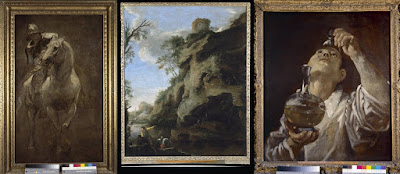Friday, March 27, 2020 -  Antiquities; Looting; Smuggling; Collecting; Collections; iraq,Green Collection.,Hobby Lobby,illicit trafficking,Museum of the Bible
Antiquities; Looting; Smuggling; Collecting; Collections; iraq,Green Collection.,Hobby Lobby,illicit trafficking,Museum of the Bible
 No comments
No comments
 Antiquities; Looting; Smuggling; Collecting; Collections; iraq,Green Collection.,Hobby Lobby,illicit trafficking,Museum of the Bible
Antiquities; Looting; Smuggling; Collecting; Collections; iraq,Green Collection.,Hobby Lobby,illicit trafficking,Museum of the Bible
 No comments
No comments
Steve Green to return another 11,500 antiquities to the Iraqi and Egyptian governments, but let's not forget the past.
Journalist Kelly Crow, in a Wall Street Journal exclusive, reports that Hobby Lobby magnate Steve Green has agreed to return an additional 11,500 antiquities to the Iraqi and Egyptian governments. Consisting mostly of papyrus fragments and ancient clay objects, the collection pieces, originally destined for the philanthropist's museum project, are being relinquished to their source country because they all lack ownership histories.
No a big surprise there. It is something academics have been worriedly asking the collector and his museum about for years.
Seemingly apologetic, the billionaire behind the $800 million, eight-story Museum of the Bible, told the Wall Street Journal “One area where I fell short was not appreciating the importance of the provenance of the items I purchased,” adding when he started collecting biblical-era antiquities in 2009 he “knew little about the world of collecting.”
I'd like to remind ARCA's readership that by the time we published our first article on Green's buying antiquities like hotcakes, in October 2015, the Hobby Lobby craft store giant had already purchased an estimated 40,000 objects for their collection, in just six years. These included Dead Sea Scroll fragments, biblical papyri, rare biblical texts and manuscripts, cuneiform tablets, Torah scrolls, and rare printed Bibles.
That's 6,666 objects per year or a whopping 18 objects purchased per day.
Looking at that from a transactional basis, I would say that Mr. Green's excuse of knowing little about the world of collecting rings a bit hollow. Green's purchasing power, and avarice, meant his collective team knew a lil more than the average joe when it comes to the world of ancient art dealers and collectors. It is not like they made one or two wrong newbie purchases.
According to US law enforcement documents, by 2010, just one year after he had started collecting, Green, himself made a trip to the United Arab Emirates to eyeball some 5,548 artefacts reportedly worth millions. This same law enforcement complaint states that the objects “were displayed informally...” “spread on the floor, arranged in layers on a coffee table, and packed loosely in cardboard boxes, in many instances with little or no protective material between them.”
Afterward, according the United States of America v. Approximately Four Hundred Fifty (450) Ancient Cuneiform Tablets et al, "On or about December 8, 2010, the President [Steve Green] authorized payment of $1,600,000 million U.S. Dollars for the Order to be wired to seven personal bank accounts associated with five different individuals."
For a man known to watch his financial line to the level Green does within his craft store empire, for me it is inconceivable to believe that an individual of this billionaire's stature would fork out millions, buying ancient objects without at least a tacit knowledge that he might need to ask questions of the dealers and suppliers he was buying material from.
For years now I have been saying that if the Greens truly want to make amends, they should fill their future Museum of the Bible with acquisitions collected ethically. In addition they should also make the details of their past purchases open and searchable to external researchers and investigators not just relinquishing batches of suspect objects purchased without sufficient moral and ethical consideration.
During the first handover of antiquities Green said “We should have exercised more oversight and carefully questioned how the acquisitions were handled.” Unfortunately it took him another five whole years to muster up the gumption to admit that these additional 11,500 objects were also likely purchased in the same haphazard manner as the ones relinquished earlier.
I don't know about most folks but if I had the capability of writing million checks dollar checks, and had already once had my feet held to the fire for purchasing antiquities that didn't pass muster, I think that I would likely remember all the other occasions when I wrote eye-popping checks for astronomical sums for equally suspect, not fully-thought out, purchases from individuals who were not completely transparent about where their merchandise was coming from.
Why it took Green five years to do the right thing on this other set of objects is therefore not to be applauded. The people in Egypt and Iraq who loot to feed the collecting appetites of Westerners spend years in jail when caught. But big dollar collectors like Steve Green, who incentivise that very plunder, seem to think that showing remorse in a financial journal or a Hobby Lobby press release should suffice.
For me it isn't.
Put your collection on line Mr. Green.
Then I will truly believe that you are sincerely sorry for what you have done. Help researchers, who can connect dodgy dealers put a dent in the illicit supply chain. Just giving back boxes and boxes of pretty baubles to the countries your dollar has plundered doesn't undo the damage you have done.
Put your collection on line Mr. Green.
Then I will truly believe that you are sincerely sorry for what you have done. Help researchers, who can connect dodgy dealers put a dent in the illicit supply chain. Just giving back boxes and boxes of pretty baubles to the countries your dollar has plundered doesn't undo the damage you have done.
Op/Ed: Lynda Albertson






























